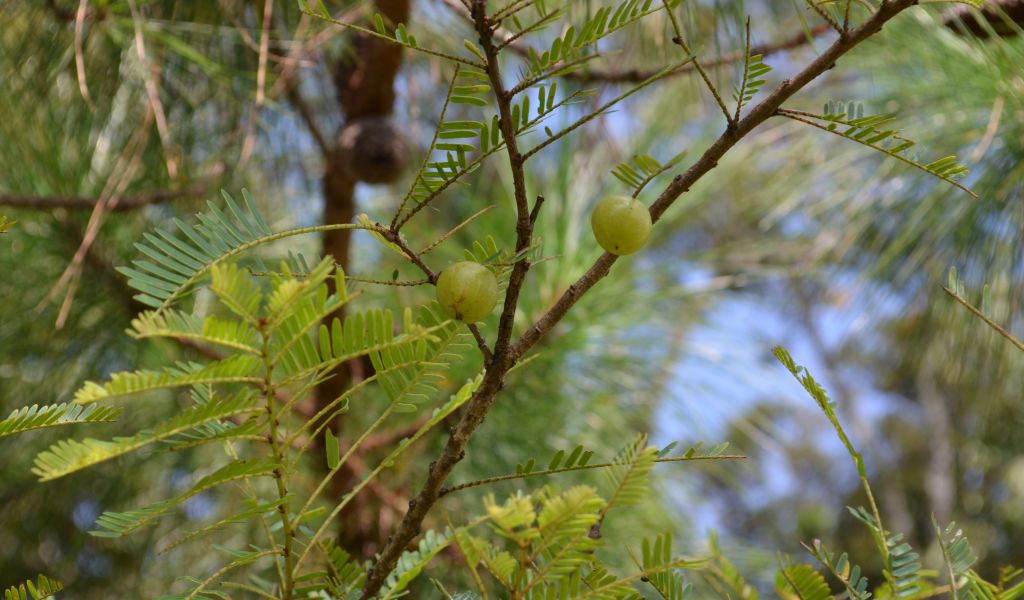ໝາກຂາມປ້ອມ / Country Gooseberry
APA 6th ed. ໝາກຂາມປ້ອມ / Country Gooseberry. (2019, April 3). Retrieved from https://www.phakhaolao.la/kb/0000198
MLA 8th ed. ໝາກຂາມປ້ອມ / Country Gooseberry. Pha Khao Lao, 3 April 2019, https://www.phakhaolao.la/kb/0000198.
Chicago 17th ed. Pha Khao Lao. 2019. "ໝາກຂາມປ້ອມ / Country Gooseberry." Published April 3, 2019. https://www.phakhaolao.la/kb/0000198.

Diasperus emblica (L.) Kuntze
Dichelactina nodicaulis Hance
Emblica arborea Raf.
Emblica officinalis Gaertn.
Phyllanthus glomeratus Roxb. ex Wall. [Invalid]
Phyllanthus mairei H.Lév.
Phyllanthus mimosifolius Salisb.
Phyllanthus taxifolius D.Don
English: Country gooseberry, Emblic myrabolan, Malacca tree
French: Phyllanthe emblic
Javanese/Sumatran: Kemlaka/Balaka, Balangka
Khmer: Kan tout prey
Malay: Kayu laka, Kik, Laka-laka, Malaka, Melaka, Toa lang
Sanskrit: Adiphala, Amalaki, Dhatri
Thai: Kam thuat, Kan tot, Ma kham pom, Mang lu, San-ya-sa
Vietnamese: Chùm ruột núi, Chùm ruột rừng, Mác kham, Mận rừng, Me qủa tròn
Phyllanthus emblica is a medium size deciduous tree. Stem bark thick, smooth, greenish and axfoliating. Leaves distichously, closely arranged to give the false apparance of a pinnate leaf, feathery, small, oblong and acute. Inflorescence in axillary, flowers monoecious fascicles, females flowers sessile, pale green. Fruits depressed globose, fleshy when young; in the beginning, the fruit appears to be drupaceous because of the fleshy pericarp and finally dry up and break up into 6 lobes. 1 seeded cocci. Flowering and fruiting from May to July.
Lao healers usually used the stem bark in the form of decoction as a medicine for reducing high blood pressure symdromes. In India, the plant is used as aperient, aphrodisiac, astringent, digestive, diuretic, laxatice, refregirant and tonic. It is also used in anaemia, asthma, biliousness, diabetes, dyspepsia, emaciation, consumption, jaundice and haemorrhagic disorder. In Malaysia, the root bark is useful in the treatment of ulcerative stomatitis. The extract of the fresh bark, mixed with honey and tumeric is given to treat gonorrhoea. The decoction of the leaves is used to treat fever. The powdered of the seeds are used to heal bronchitis and asthma. In Vietnam the decoction of salty fruits (15-20g) is used for treating diabetes.
According to oriental medicine theory, the fruits have sour, sweet taste, slightly acrid, cool character, have antipyretic, anti-inflammatory actions, purging lung, produce mucous. The leaves have hot taste, calm character, possess diuretic action. The root is bitter, acrid, calm character, astringent and has hypotensive effect. The stem bark has also astringent effect. The flowers possess refregirant, antipyretic and laxative effects.
.
